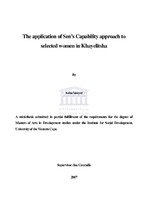| dc.contributor.advisor | Conradie, Ina | |
| dc.contributor.author | Sawyer, Asha | |
| dc.contributor.other | Institute for Social Development | |
| dc.contributor.other | Faculty of Arts | |
| dc.date.accessioned | 2013-08-02T13:29:00Z | |
| dc.date.available | 2009/10/08 15:27 | |
| dc.date.available | 2009/10/08 | |
| dc.date.available | 2013-08-02T13:29:00Z | |
| dc.date.issued | 2007 | |
| dc.identifier.uri | http://hdl.handle.net/11394/1789 | |
| dc.description | Masters of Art | en_US |
| dc.description.abstract | Measuring poverty adequately is critical for any type of development project, and yet there are still no clear guidelines as to which approach is best to be used for different circumstances. There is a variety of different ways of measuring and understanding poverty, each with their own advantages and disadvantages, depending on the intended goal. This research explored the theory regarding poverty and poverty measurements, and research various perspectives ranging from income to basic needs, socail exclusion, sustainable livelihoods, and finally to the Human Development Approach. | en_US |
| dc.language.iso | en | en_US |
| dc.publisher | University of the Western Cape | en_US |
| dc.subject | Poverty | en_US |
| dc.subject | Research | en_US |
| dc.subject | South Africa | en_US |
| dc.subject | Cost and standard of living | en_US |
| dc.subject | Women | en_US |
| dc.subject | Poverty research | en_US |
| dc.title | The application of Sen's Capability approach to selected women in Khayelitsha | en_US |
| dc.type | Thesis | en_US |
| dc.rights.holder | University of the Western Cape | en_US |
| dc.description.country | South Africa | |

